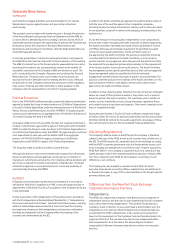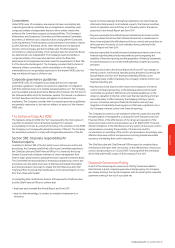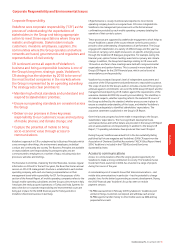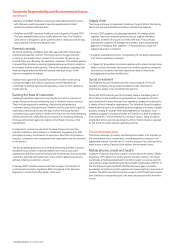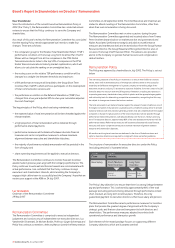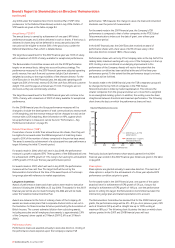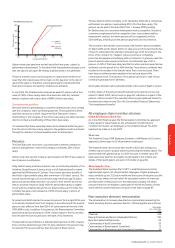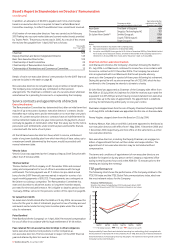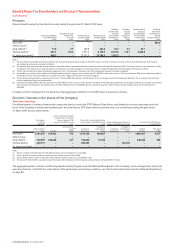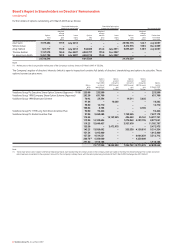Vodafone 2007 Annual Report Download - page 79
Download and view the complete annual report
Please find page 79 of the 2007 Vodafone annual report below. You can navigate through the pages in the report by either clicking on the pages listed below, or by using the keyword search tool below to find specific information within the annual report.
Vodafone Group Plc Annual Report 2007 77
GovernanceGovernance
Vodafone requires manufacturers of the mobiles it sells to test for SAR
(“Specific Absorption Rate”) compliance when used both against the ear
and against, or near, the body, using the US FCC Test procedure. Vodafone is
actively engaged with the IEC Standards Organisation in developing a new
global protocol for body worn phones. At the end of 2006, the operating
companies completed a two year implementation programme of the
Group’s Health and Safety of Radio Frequency Fields Policy to ensure all its
base stations comply with international standards. The Group’s long term
programme of engagement, with a range of stakeholders, aims to reduce
levels of concern amongst the public and to demonstrate that Vodafone is
acting responsibly.
Responsible network deployment
Vodafone’s mobile services rely on a network of base stations that transmit
and receive calls. The Group recognises that network roll out can cause
concern to communities, usually about the visual impact of base stations or
health issues concerning RF fields. Vodafone has continued to implement
its policy and guidelines on responsible network deployment. In addition,
seven mobile operating companies have signed up to national industry
codes of best practice on network deployment.
During the 2007 financial year, Vodafone was found in breach of planning
regulations relating to 423 mast sitings. Fines levied by regulatory bodies or
courts in relation to offences under environmental law or regulations were
approximately £16,500.
By cooperating with other mobile operators to share sites, the Group can
reduce the total number of base stations required. This lowers costs,
enables faster network deployment and reduces the environmental
footprint of the network without loss of quality or coverage. During the year,
Vodafone announced the intention to participate in a number of network
sharing agreements in the Czech Republic, Spain and the UK.
Energy use and efficiency
Climate change is widely recognised as the greatest global environmental
challenge and limiting the Group’s contribution is a priority. One of the
Group’s significant areas of impact is the energy use associated with the
operation of the network, which accounts for more than 80% of the Group’s
carbon dioxide emissions. In the 2007 financial year:
•energy use was 2,690 GWh, equating to 1.23 million tonnes of carbon
dioxide; and
•network carbon dioxide emissions per unit of data transmitted decreased
by 29%.
Other environmental impacts include ozone-depleting substances, paper
use and water use. These are reported at www.vodafone.com/responsibility.
Reuse and recycling
Mobile phones, accessories and the networks on which they operate require
upgrading, replacement and decommissioning. Whilst Vodafone does not
manufacture equipment, the Group does purchase it. New European
legislation on electronic waste came into force during the 2007 financial
year. The Group complies with the EU’s Waste Electronic and Electrical
Equipment (“WEEE”) directive through its handset recycling programmes in
all operating companies where it applies. The Group has also worked with
suppliers to ensure substances prohibited by the Restriction of the use of
certain Hazardous Substances directive are phased out. During the 2007
financial year:
•Over one million phones were collected for reuse and recycling through
collection programmes in 16 mobile operating companies. This exceeds
our target of increasing our handset collection by 50% from 2005 levels
(the target figure was adjusted to take into account the disposal of the
operations in Japan); and
•9,960 tonnes of network equipment waste was generated, with 97% of
this sent for reuse or recycling, exceeding our target of 95%.
Environmental Performance Indicators
2007(1)(2) 2006(1)(3) 2005(1)
Number of mobile operating subsidiaries
undertaking independent RF field monitoring 15 15 14
Total energy use (GWh) (direct and indirect) (4) 2,690 2,900(5) 2,600
Total carbon dioxide emissions
(millions of tonnes)(4) 1.23 1.31 1.2
% of energy sourced from renewables 17 12 11
Number of phones collected for reuse and
recycling (million) 1.03 1.37 1.14(5)
Network equipment waste generated (tonnes) 9,960 2,950 3,404
% network equipment waste sent for reuse
or recycling 97 97 96
Notes:
(1) These performance indicators were calculated using actual or estimated data collected by the
Group’s mobile operating companies. The data is sourced from invoices, purchasing requisitions,
direct data measurement and estimations where required. The carbon dioxide emissions figure
is calculated using the kWh/CO2 conversion factor for the electricity provided by the national
grid and for other energy sources in each operating company. The data collection and reporting
process is within the assurance undertaken by Deloitte & Touche LLP on the Company’s CR
Report. The Group’s joint venture in Italy is included in all years.
(2) The data for the 2007 financial year excludes the newly acquired operations in Turkey and the
operations in Japan that were sold during the 2007 financial year.
(3) The data for the 2006 financial year excludes the Czech Republic, Romania and the operations
in Sweden that were sold during the 2006 financial year, but does include operations in Japan
that were disposed of during the 2007 financial year.
(4) The 2007 figure includes Arcor.
(5) Figures corrected after further analysis of data obtained during the last financial year.







